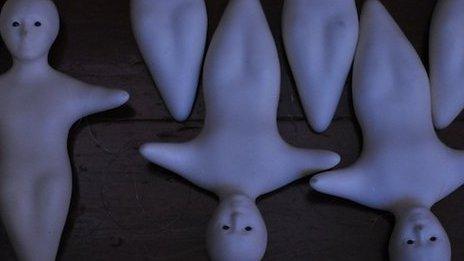Innorobo 2013 - Here come the robots
- Published
It has long been predicted that robots will one day rule the world, and in a small enclave in Lyon, France, they are showing just what they are capable of.
Innorobo is a conference dedicated to service robots, from those already commercially available and helping us with our everyday chores to concept robots that may change lives in the future.
The BBC has been floor walking in Lyon with a variety of robots and brings you the pick of the show.
Robotic salamander

A robotic salamander that walks and swims like the real thing
Perhaps the robot creating the most buzz at this year's Innorobo was a mechanical salamander.
Developed at the Biorobotics Laboratory in Lausanne, the project could have big implications for the study of human paralysis, as well as being the forerunner to amphibious robots that can both walk and swim.
The team set out to mimic the way the spinal column of a salamander works. They chose this particular creature partly because of its simple neural circuits and partly because it can move on both the land and water.
"The robot is not a goal in itself," explained researcher Kostas Karakasiliotis.
"It is about trying to reproduce the neural system to help understand our own neural networks."
The researchers collaborated with neurobiologists to create a robot that moves surprisingly like the real thing. You can watch it in action here, external.
Minimal human

Telenoid grew out of a desire to transform telecommunications
PhD research student Kohei Ogawa wants to reinvent the world of telecommunications, or, as he puts it, "use a robot to achieve tele-existence, where you transfer human presence to another place."
To do this he has come up with a telenoid robot, a kind of Skype in semi-human form. It is basically a VoIP service but with a face and body. It has basic phone functionality, but is also capable of recognising a user's motions via sensors inside the robot.
It means that as well as basic talking, the robot can also move its head and arms and can even offer 'virtual hugs', meaningful, for instance, when a grandchild calls its grandparent.
Currently, it is a research project at the Intelligent Robotics Laboratory at Osaka University in Japan. The lab is headed up by Prof Hiroshi Ishiguro who famously made a robot in his own image.
In tests, the telenoid has already proved a hit, particularly with older people, Mr Ogawa told the BBC.
Watch the robot in somewhat creepy action here, external.
Robot smartphones

A smartphone can act as a powerful robot brain
Robots can be expensive to make so why not make use of something we all carry around with us - the mobile phone?
Increasingly, machines are hitting the market that are basically mobile phones on a robotic trolley.
At the TED show in Los Angeles, an iPhone-compatible robot called Romo was shown off, and at Innorobo, SmartBot was being put through its paces.
Unlike Romo it can also work with Android and Windows-based smartphones as welll as iOS devices.
"The smartphone is a very hi-tech device and if we use it as a brain we can create a robotic prodigal," said Pierre Guedon, chief executive at Overdrive Robotics, the firm behind SmartBot.
The SmartBot goes on sale in April, for €160 in Europe, and will come with 12 apps. One allows users to program to take photos, while another offers remote controlled video conferencing.
And for those who do not want to use it with a smartphone, it can be adapted to carry a number of other things, such as the Arduino micro-controller and even Lego bricks.
Watch SmartBot here, external.
Public service

There were quite a few robots offering advice at the show
In the smart cities of the future robots are likely to be on every street corner, offering us advice when we get lost, guiding us around museums, shopping malls and hospitals.
In Seoul, Furo has offering advice in shopping malls for the past three years and now is coming to cities in China, France, Brazil and Japan.
It was one of several similar robots on show at the conference.
Gilberto, from Swiss firm BlueBotic, guided people around the conference floor, offering information about the show in 15 languages.
Back at home in Switzerland, Gilberto acts as a guide in the Museum of Robotics.
BlueBotic has also made a proto-type coffee-making robot named Nesbot, who currently resides in the head office of Nespresso.
See Furo in action here, external.
You can view other Touts from the Innorobo conference on the BBC's Tout channel., external
- Published16 March 2012